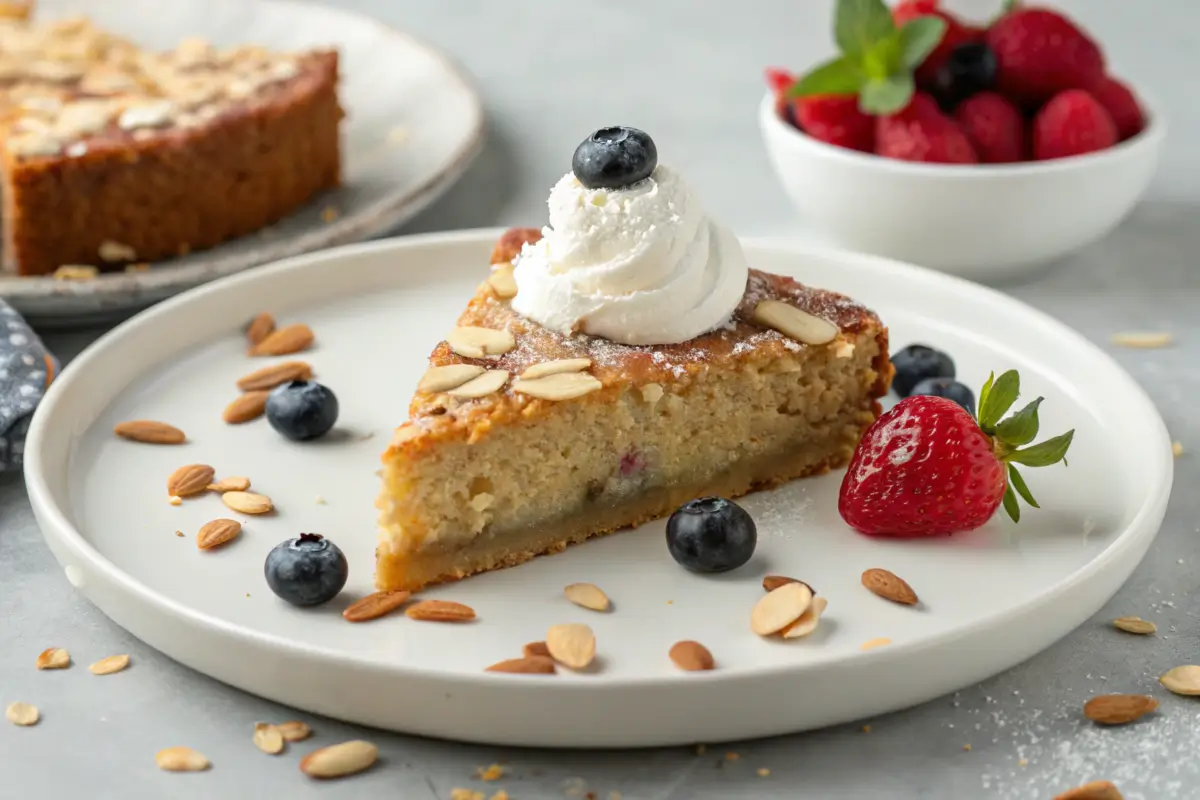Few desserts can rival the delightful combination of nuttiness and sweetness found in an almond nut cake recipe. Whether you’re a seasoned baker or just starting, this guide covers everything you need to create the perfect almond nut cake, from essential ingredients to creative variations and troubleshooting tips. This versatile recipe, which can also be referred to as an almond flour cake recipe or nut cake recipe, is ideal for breakfast, coffee breaks, or even special occasions. Ready to bake something extraordinary? Let’s dive in!
Introduction to Almond Nut Cake
What Makes Almond Nut Cake Unique?
The almond nut cake recipe holds a special place in the world of desserts, blending a rich, nutty flavor with a moist, tender crumb. Unlike traditional cakes, this one leverages the natural oils and texture of almonds, making it both luxurious and versatile. Whether served at a fancy dinner or a casual family gathering, this cake always steals the show.
History and Origin of Almond Cakes
Almond cakes trace their origins to ancient Persia, where almonds symbolized wealth and prosperity. Over centuries, they traveled across cultures, morphing into regional specialties like Italy’s torta di mandorla and France’s gâteau aux amandes. The modern almond nut cake combines these traditional flavors with contemporary techniques for a treat that’s both timeless and trendy.
Health Benefits of Almonds in Baking
Aside from their delectable flavor, almonds pack a punch of health benefits. They’re rich in vitamin E, magnesium, and healthy fats, which can boost heart health and provide sustained energy. Using almond flour or ground almonds in your cake adds a gluten-free twist while keeping the texture irresistibly moist. In short, baking with almonds is as nutritious as it is delicious.
Ingredients for the Perfect Almond Nut Cake Recipe
Core Ingredients for Almond Nut Cake Recipe
The foundation of a mouthwatering almond nut cake recipe lies in its high-quality ingredients. For this recipe, you’ll need:
- Almond Flour or Ground Almonds: These are the stars of the show, providing a nutty richness. Use finely ground almonds for a smoother texture or almond flour for a lighter cake.
- Eggs: Essential for structure and moisture, eggs also help bind the ingredients together.
- Sugar: Regular granulated sugar works well, but you can substitute with coconut sugar for a hint of caramel.
- Butter: Adds depth and richness. Unsalted butter is preferred to control the cake’s saltiness.
- Vanilla Extract: For an aromatic hint that elevates the almond flavor.
- Baking Powder: Ensures your cake rises beautifully.
Optional Additions for Flavor Variations
Want to give your cake a creative twist? Consider these variations:
- Zest of Lemon or Orange: Adds a citrusy freshness.
- Chopped Nuts: Sprinkle chopped almonds, pistachios, or walnuts for texture.
- Spices: A dash of cinnamon or nutmeg can add warmth to the flavor.
Substitutions for Dietary Preferences
This recipe is naturally gluten-free when using almond flour. For other dietary needs:
- Vegan Option: Replace eggs with flaxseed or chia egg substitutes.
- Low-Sugar Alternative: Swap sugar for a natural sweetener like stevia or erythritol.
Step-by-Step Almond Nut Cake Recipe
Preparation: Tools for Baking Your Almond Cake Recipe
Before diving into the recipe, gather these essentials:
- A mixing bowl, whisk, and spatula
- A 9-inch cake pan (lined with parchment paper)
- An electric mixer for a fluffier batter
Preheat your oven to 350°F (175°C). This ensures even baking from the start.

Mixing the Batter: Key Techniques
- Cream Butter and Sugar: Use an electric mixer to cream softened butter and sugar until light and fluffy. This step creates an airy texture.
- Add Eggs Gradually: Beat in eggs one at a time, allowing each to incorporate fully before adding the next.
- Fold in Dry Ingredients: Gently fold almond flour, baking powder, and any additional flavors into the wet mixture. Avoid overmixing to keep the batter airy.
Baking: Optimal Temperatures and Timings
- Pour the batter into the prepared pan, smoothing the top with a spatula.
- Bake in the preheated oven for 25-30 minutes or until the top turns golden and a toothpick inserted in the center comes out clean.
- Allow the cake to cool in the pan for 10 minutes before transferring it to a wire rack.
Tips for Ensuring a Moist and Fluffy Texture
- Don’t overbake—keep an eye on the oven during the last few minutes.
- Use room-temperature ingredients to ensure even mixing.
- Adding a dollop of yogurt or sour cream to the batter can enhance moisture.
Creative Variations and Serving Ideas
Flavor Twists: Chocolate, Citrus, and Spices
Elevate your almond nut cake recipe with a touch of creativity:
- Chocolate Almond Cake: Add 1/4 cup of cocoa powder to the batter and top with melted dark chocolate for a rich, indulgent twist.
- Citrus Burst: Fold in the zest of one orange or lemon for a tangy aroma that pairs beautifully with the almonds.
- Spiced Delight: A teaspoon of cinnamon or a pinch of nutmeg transforms your almond cake into a warm, comforting dessert.
Decorating Your Almond Nut Cake for Occasions
Presentation matters, especially for special occasions. Try these ideas:
- Simple Elegance: Dust the cake with powdered sugar and garnish with toasted almond slices.
- Celebration Ready: Spread cream cheese frosting or whipped cream on top, then sprinkle crushed pistachios for added color.
- Seasonal Charm: Decorate with edible flowers or fresh fruits like raspberries or figs for a vibrant, festive look.
Pairing Suggestions: Drinks and Side Dishes
The almond nut cake pairs delightfully with:
- A warm cup of coffee or espresso for a classic combination.
- Herbal teas like chamomile or green tea to complement its nutty flavor.
- A side of vanilla ice cream or fresh fruit compote to add a refreshing balance.
Common Mistakes and How to Avoid Them
Overmixing or Undermixing the Batter
One common mistake when making the almond nut cake recipe is improper mixing. Overmixing can make the cake dense, while undermixing leads to uneven textures. Always mix until the ingredients are just combined.
Preventing a Dry or Dense Cake
- Check Oven Temperature: Use an oven thermometer to ensure accuracy. Baking at too high a temperature can dry out the cake.
- Measure Precisely: Too much almond flour can make the cake crumbly. Use a kitchen scale for precise measurements.
- Incorporate Moisture: Adding a tablespoon of milk or yogurt keeps the cake soft and fluffy.
Troubleshooting Baking Mishaps
- Sunken Middle: This happens when the cake isn’t fully baked. Test with a toothpick; it should come out clean.
- Burnt Edges: Use a lighter-colored cake pan and keep the pan centered in the oven.
- Cracked Top: While natural for almond cakes, you can reduce this by baking at a slightly lower temperature.
FAQs About Almond Nut Cake Recipe
How Long Does Almond Nut Cake Stay Fresh?
An almond nut cake recipe stays fresh for about 3-4 days when stored properly. Keep it in an airtight container at room temperature to maintain its moist texture. If you’re in a warm climate, consider refrigerating the cake to prevent spoilage. Just bring it to room temperature before serving for the best taste.
Can Almond Nut Cake Be Made Vegan?
Yes, absolutely! To make a vegan version, swap eggs with flaxseed or chia egg substitutes (1 tablespoon of flaxseed/chia mixed with 3 tablespoons of water per egg). Replace butter with plant-based margarine or coconut oil for a rich, moist texture.
What Are the Best Almonds to Use?
For the best flavor, use high-quality raw almonds or blanched almond flour. Raw almonds can be ground at home for a fresher, nuttier taste. Avoid roasted or salted almonds as they can alter the flavor of your cake.
Can I Use Almond Flour Instead of Ground Almonds?
Yes, almond flour works well in this almond nut cake recipe. It’s finer than ground almonds and gives the cake a lighter texture. Just ensure you measure it correctly to avoid overpacking the flour.
Final Thoughts and Encouragement to Try the Recipe
Why You’ll Love This Recipe
This almond nut cake recipe is a must-try for its delightful combination of flavor, texture, and simplicity. Its moist crumb and nutty aroma make it the perfect dessert for any occasion. Plus, the recipe’s flexibility allows you to tailor it to your preferences, whether gluten-free, vegan, or sugar-reduced.
Encouraging Customizations and Feedback
Baking is all about experimentation and sharing your creations. Don’t be afraid to add your personal touch to this almond nut cake recipe. Whether it’s a dash of cinnamon, a hint of citrus, or a chocolate glaze, your twist could make it even more special.
Creative Storage and Serving Suggestions
How to Store Your Almond Nut Cake
Proper storage is essential to keep your almond nut cake recipe fresh and flavorful. Follow these simple tips:
- Room Temperature: If you plan to enjoy the cake within 2-3 days, store it in an airtight container at room temperature. Make sure it’s away from direct sunlight or heat sources.
- Refrigeration: For longer storage (up to a week), wrap the cake tightly in plastic wrap and place it in the fridge. This method retains its moisture and texture.
- Freezing: Need to keep it longer? Freeze individual slices wrapped in parchment paper, then seal them in a freezer bag. Thaw slices at room temperature when ready to serve.

Serving Tips for Maximum Enjoyment
Make your almond nut cake recipe stand out by serving it with complementary sides or enhancements:
- Simple Elegance: Dust the top with powdered sugar and serve with a dollop of whipped cream.
- Seasonal Pairings: In summer, serve with fresh berries; in winter, drizzle with warm caramel sauce.
- Savory Contrast: Pair small slices with a cheese platter for a unique, balanced dessert option.
Nutritional Information
Nutritional Content (Per 100g)
Understanding the nutritional value of your almond nut cake recipe can help you make informed choices while enjoying this delightful dessert. Below is the nutritional breakdown per 100 grams:
| Nutrient | Amount (Per 100g) |
|---|---|
| Calories | 430 kcal |
| Total Fat | 26 g |
| Saturated Fat | 5 g |
| Cholesterol | 55 mg |
| Sodium | 120 mg |
| Total Carbohydrates | 36 g |
| Dietary Fiber | 4 g |
| Sugars | 22 g |
| Protein | 8 g |
| Calcium | 85 mg |
| Iron | 1.5 mg |
Key Nutritional Insights
- High in Protein and Healthy Fats: Thanks to almonds, this cake provides a good source of plant-based protein and heart-healthy fats.
- Moderate Sugar Content: While sweet, you can reduce the sugar by substituting with natural sweeteners.
- Rich in Fiber: With 4 grams of fiber per 100g, it can support digestive health.
This nutritional breakdown makes it easy to enjoy your almond nut cake recipe mindfully while savoring its rich flavors. Would you like to include calorie-conscious tips for this recipe?
Reader Reviews and Recipe Variations
What Others Are Saying
This almond nut cake recipe has been a crowd favorite for its simplicity and versatility. Home bakers rave about how easy it is to customize, while professional chefs appreciate its balanced sweetness and moist crumb.
- “I tried this recipe with a touch of orange zest—it was a hit at my dinner party!”
- “As someone with gluten sensitivities, I love how this recipe is naturally gluten-free without compromising on texture.”
- “The chocolate variation was amazing! My kids couldn’t get enough.”
Popular Variations
Over time, bakers have put their own spin on this classic recipe:
- Paleo Almond Cake: Swap sugar with honey or maple syrup and use coconut oil for a paleo-friendly version.
- Lemon-Almond Drizzle Cake: Add a lemon glaze made of powdered sugar and fresh lemon juice for a zesty finish.
- Almond-Chocolate Marble Cake: Create a swirl effect by mixing in a cocoa powder batter with the original.

